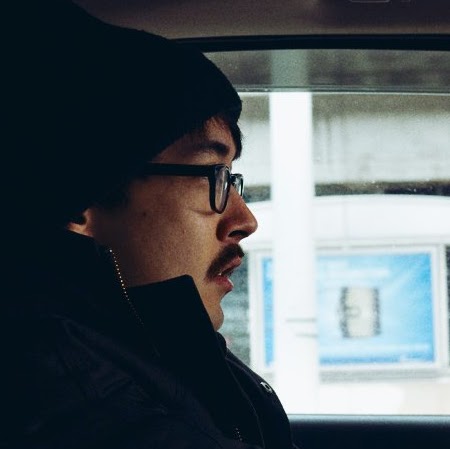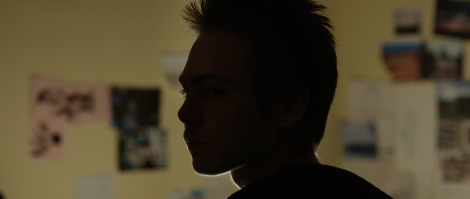
Christopher Radcliff is an award-winning writer, editor and filmmaker. His and co-director/co-writer Lauren Wolkstein’s short film The Strange Ones had its World Premiere at the 2011 Sundance Film Festival before touring internationally to significant acclaim. Their most recent collaboration, Jonathan’s Chest, was written and directed by Radcliff and produced by Wolkstein and Autumn Tarleton; it was nominated for the Short Film Grand Jury Prize at the 2014 Sundance Film Festival. Christopher Radcliff spoke with Sean Malin of CineMalin: Film Commentary and Criticism about returning to Park City with another short, the benefits of a strong creative partnership, and the dark origins of Jonathan’s Chest. This interview has been transcribed, compressed, and edited from audio for publication.
*****
Sean Malin: You’re primarily known for the short films you’ve made, but as several of my recent interviews with Sundance shorts directors have revealed to me, it’s hard to make any money that way. How do you find your bread-and-butter?
Chris Radcliff: It’s true that there’s really no way to monetize your short film in this country. But I think that actually makes making a short film more intriguing, in a sense, because they are usually made for purely creative reasons or as a “calling card” to get a feature. I certainly didn’t make either of my films to make money, and I don’t know many others who do…
SM: What confuses me about this, having heard it so often recently from other filmmakers, is that I see the lines blurring between “short films” and narrative music videos, the stuff on Funny-or-Die, or webisodes. And there are also some supportive short-exclusive film festivals in the country, not to mention Sundance.
CR: There are definitely great festivals like Sundance and many others that support and provide audiences for short films, and short content can certainly find a huge audience online. Still, in my experience, it’s extremely rare for U.S. filmmakers to make a short and expect to sell it or make their money back. I should say, though, that [co-director/co-writer] Lauren [Wolkstein] and I were lucky enough to sell The Strange Ones for distribution in several countries, including to European television, which pays quite well. In cases like ours, you can almost make your money back with those sales and prize money. The reality for any “aspiring” filmmaker is trying to find the money to make your films; going to actually make your film; and then doing what you need to do to pay your rent or eat. It’s just the state of the industry nowadays that it can be difficult to support yourself.
SM: What were the “creative reasons” that led you to make Jonathan’s Chest?
CR: I’m instinctually drawn to stories that circle around a secret of some kind. This was the attraction to making The Strange Ones and I’m drawn to those darker stories in my feature scripts, as well. After making The Strange Ones, I had decided that I would only do another short if the idea could be achieved with very little money for production; maybe something about two characters in one room, basically. my films tend to be minimal in terms of production and story requirements, but I wanted something even smaller than the previous short [which has only three speaking roles.]
I met Toby [Campbell, who plays Jonathan] when we cast him in that film, and through that casting process I also met his brother Owen, who’s also an actor. I thought they were both great and became dead-set on making something with them if it was possible. As I was doing research on some true-crime stories and history for the feature adaptation of The Strange Ones, I read about this one case where a woman claimed to have been visited by her kidnapped son, several years after he vanished. This concept of someone being visited by a missing person – like just having a meeting between someone missing and someone else – was such an intriguing one as the basis for a short. If you could just distill a film down to that one scene, give a whole story in the course of a brief conversation between two people in a room…and when I thought that, the story just clicked.

SM: Jonathan’s Chest does take this two-person motif a little further than you’ve suggested to an ambiguous kind of climax. Was the intention to toy with the audience a bit?
CR: I’ve never thought of it as, “toying with the audience” – I think that it’s more about engaging with the audience, but in such a way that they’re forced to question what they are seeing. I’m more interested in films that give viewers questions than in films that provide answers.

SM: Can you tell me about the actual production process for the film?
CR: I wrote the script about a month before we shot it in 2013. It was a pretty small production – two overnight shoots and one day-time shoot in Ditmas Park, Brooklyn. When I was writing the script, I imagined a small suburban American town like the one I grew up in outside Pittsburgh, Pennsylvania. Ditmas Park is an uncommonly suburban-looking area in New York City, so it was great to be able to shoot there. The house we shot in belongs to the parents of a dear friend of mine, the filmmaker Eliza Hittman, and the whole family was extraordinarily generous in letting us shoot there. We shot the film in fall and had about a month to get a cut ready to submit to Sundance.
SM: When your film had its World Premiere at Sundance [Film Festival 2014,] did you have the chance to watch any other films?
CR: I managed to see around twelve movies while I was at the festival, which is quite a few if you’re there with your own film. That’s one of many things that I enjoy so much about being at Sundance: when you’re there with a short, you don’t suffer from what I imagine is the immense amount of pressure that comes with premiering a feature there. I was determined to see at least a few because you can go to support a film and end up not seeing any movies the whole time you’re there. It can get really busy.
SM: See anything good? I ask because several of the big movies at Sundance this year were features adapted from shorts where the process of extending small ideas was nurtured into full-length form, like Kat Candler’s Hellion and Damien Chazelle’s Whiplash. Their acclaim must make the process you’re going through in adapting your shorts feel worthwhile.
CR: I saw some great stuff, including Hellion, which is fantastic. I got to meet Kat when she and I were on a panel together about short filmmaking, and I just think she’s an uncommonly observant and incredibly intelligent person. There’s no pretense with her, which is so rare at these events. The Zellner Brothers’ Kumiko, the Treasure Hunter was also amazing. It’s one of those films that feels like the people who made it were inspired to do so and to work at this extremely high level of creativity. That was inspiring for me – that level is what I’m aspiring toward as I’m getting ready to make my first feature. And I also saw Boyhood, from Richard Linklater…don’t you live in Austin?
SM: I do. Everyone and their brother is clamoring to see that film, and of course the town’s been really excited to screen Hellion and Kumiko at SXSW this year, finally. I would go so far as to say the whole city’s on tenterhooks for those three. Austin did pretty well for itself at Sundance.
CR: They always seem to do well at Sundance but this seemed like a pretty huge year for Austin-based filmmakers. It seemed like everyone at Sundance this year was either from Brooklyn or Austin. I’ve also been going to SXSW for a few years because The Strange Ones screened there in 2011, and then Lauren’s short [Sundance 2013 Official Selection] Social Butterfly played there. It’s always one of the best film festivals; I’m hoping we’ll get to go back.
*****
Editor’s Note: Since this interview was conducted, Jonathan’s Chest has been named an Official Selection of the 2014 SXSW Film Festival.
The editor would also like to thank the Jonathan’s Chest team for providing still images.


Pingback: Interview with Kat Candler | CineMalin: Film Commentary and Criticism·
Pingback: Interview with Lauren Wolkstein | CineMalin: Film Commentary and Criticism·